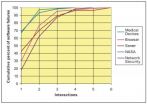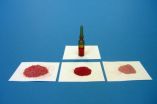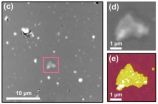Bowel cancer: 8 years of colonoscopy screening in Germany -- a success story
2010-11-11
(Press-News.org) By the end of this year, colonoscopy screening will have prevented bowel cancer in approximately 99 000 people since it was introduced in Germany. This is the result obtained by Hermann Brenner of the German Cancer Research Center in Heidelberg and his co-authors in their interim assessment conducted eight years after the procedure was added to the German cancer screening program. The authors present their projection and initial results of colonoscopy screening in Germany in the current edition of Deutsches Ärzteblatt International (Dtsch Arztebl Int 2010: 107(43): 753 9). The article was accompanied by an editorial on the subject written by Stefanie Klug of the Dresden University of Technology (Dtsch Arztebl Int 2010; 107(43): 751 2).
On the basis of German registry data, Brenner et al. determined the rates of participation in screening and the prevalence of advanced adenomas and carcinomas detected early, for each year from 2003 to 2008. Their projections for 2009 and 2010 were based on the values recorded for 2008.
The study showed that advanced adenomas had been identified and removed in more than 300 000 screening participants in the first eight years of the screening colonoscopy program. The projections showed that this had prevented approximately 99 000 cases of bowel cancer. If they had not been removed, these advanced adenomas would have become clinically manifest a median of 10 years after screening colonoscopy. Over the same period, approximately 50 000 colorectal carcinomas were detected early as a result of screening colonoscopy, mostly still at a curable stage.
In the authors' view, still more cases would be prevented if the participation rate could be improved, using targeted invitations for example.
Screening colonoscopy has been offered as part of cancer screening in Germany since October 2002. It is available to men and women aged 55 and older.
INFORMATION:
Contact: Dr. Stefanie Seltmann, Head of Press and Publicity, German Cancer Research Center presse@dkfz.de
http://www.aerzteblatt.de/v4/archiv/pdf.asp?id=78991
http://www.aerzteblatt.de/v4/archiv/pdf.asp?id=78990
ELSE PRESS RELEASES FROM THIS DATE:
2010-11-11
Researchers at the National Institute of Standards and Technology (NIST) have released an updated version of a computer system testing tool that can cut costs by more efficiently finding flaws. A tutorial on using the tool accompanies the new release.
Catching software "bugs" before a program is released enhances computer security because hackers often exploit these flaws to introduce malware, including viruses, to disrupt or take control of computer systems. But it's difficult. A widely cited 2002 study prepared for NIST* reported that even though 50 percent of software ...
2010-11-11
A team of researchers from the University of Minnesota's College of Liberal Arts and College of Science and Engineering have found that an early part of the brain's visual system rewires itself when people are trained to perceive patterns, and have shown for the first time that this neural learning appears to be independent of higher order conscious visual processing.
The researchers' findings could help shape training programs for people who must learn to detect subtle patterns quickly, such as doctors reading X-rays or air traffic controllers monitoring radars. In addition, ...
2010-11-11
National Institute of Standards and Technology (NIST) researchers have developed new certified reference materials for measuring amounts of organic acids in dietary supplements formulated with Vaccinium berries—cranberries, blueberries and bilberries. As described in a recent paper,* manufacturers and researchers can use this new suite of standard reference materialsTM (SRMs) as quality assurance tools.
berry SRMs
Dietary supplement manufacturers often include health claims on products made with Vaccinium berries. Suggested benefits include prevention of urinary tract ...
2010-11-11
Many aspects of the German Genetic Diagnostics Act (Gendiagnostikgesetz) are out of touch with the latest technology, almost impossible to implement in clinical practice, or even detrimental to the success of recognised screening tests, such as newborn screening. The Act, which came into force in February 2010, is in desperate need of amendment. This was the conclusion reached by the Academy Workgroup "Predictive genetic diagnostics as an instrument of disease prevention" of the German Academy of Sciences Leopoldina, the Berlin-Brandenburg Academy of Sciences and Humanities ...
2010-11-11
Using a neutron beam as a probe, researchers working at the National Institute of Standards and Technology (NIST) have begun to reveal the crystal structure of a compound essential to technologies ranging from sonar to computer memory. Their recent work* provides long-sought insight into just how a widely used material of modern technology actually works.
The compound is a "piezoelectric," a material capable of changing one kind of energy into another—mechanical to electrical, or vice versa. Long employed in sonar systems to detect sound waves, more recently piezoelectrics ...
2010-11-11
VIDEO:
Wireless. For most, the word conjures images quaint coffee shops or busy airport lobbies -- places where people drop in to check on business or check in with other people.
But...
Click here for more information.
BEAUMONT – Wireless. For most, the word conjures images quaint coffee shops or busy airport lobbies – places where people drop in to check on business or check in with other people.
But increasingly "wireless" is showing up on the farm to help produce better ...
2010-11-11
The researchers characterize their new technique as a neat solution to the "needle in a haystack" problem of nanoscale microscopy, but it's more like the difference between finding the coffee table in a darkened room either by walking around until you fall over it, or using a flashlight. In a new paper,* a group from JILA—a joint venture of the National Institute of Standards and Technology (NIST) and the University of Colorado—finds tiny assemblies of biomolecules for subsequent detailed imaging by combining precision laser optics with atomic force microscopy.
The ...
2010-11-11
Neurons communicate via chemical transmitters which they store in the bubble-like synaptic vesicles and release as required. To be able to react reliably to stimulation, neurons must have a certain number of "acutely releasable" vesicles. With the help of a new method, neuroscientists at the Max Planck Institute of Experimental Medicine in Göttingen have now discovered that neurons systematically recycle the protein components necessary for transmitter release and in this way guarantee the reliability of signal transmission in the brain. If this process is disrupted, the ...
2010-11-11
Montreal, November 10, 2010 – The initial findings of a survey on the prevalence of gambling in Quebec have been released. The study also deals with behavior problems associated with gambling. The study reveals that nearly 70 percent of Quebec adults report having bet or spent money on gambling during the previous 12 months. It also found Quebecers spend an average of $483 annually on gambling activities.
This survey was conducted between June and September 2009 throughout the province among 11,888 non-institutionalized adults over the age of 18. It constitutes the first ...
2010-11-11
November 10, 2010 -- To keep soldiers in the battlefield healthy, the U.S. Army is exploring new ways to detect harmful bacteria in water.
Current techniques for analyzing water in the field can take as long as 24 hours to complete, according to Bart Lipkens of Western New England College in Springfield, Massachusetts and his colleagues at Physical Sciences in Andover, Ma.
They are working on an alternative technology that uses sound waves to accelerate the process.
"The goal of our project is to speed up the detection of bacteria in water supplies," said Lipkens. ...
LAST 30 PRESS RELEASES:
[Press-News.org] Bowel cancer: 8 years of colonoscopy screening in Germany -- a success story




